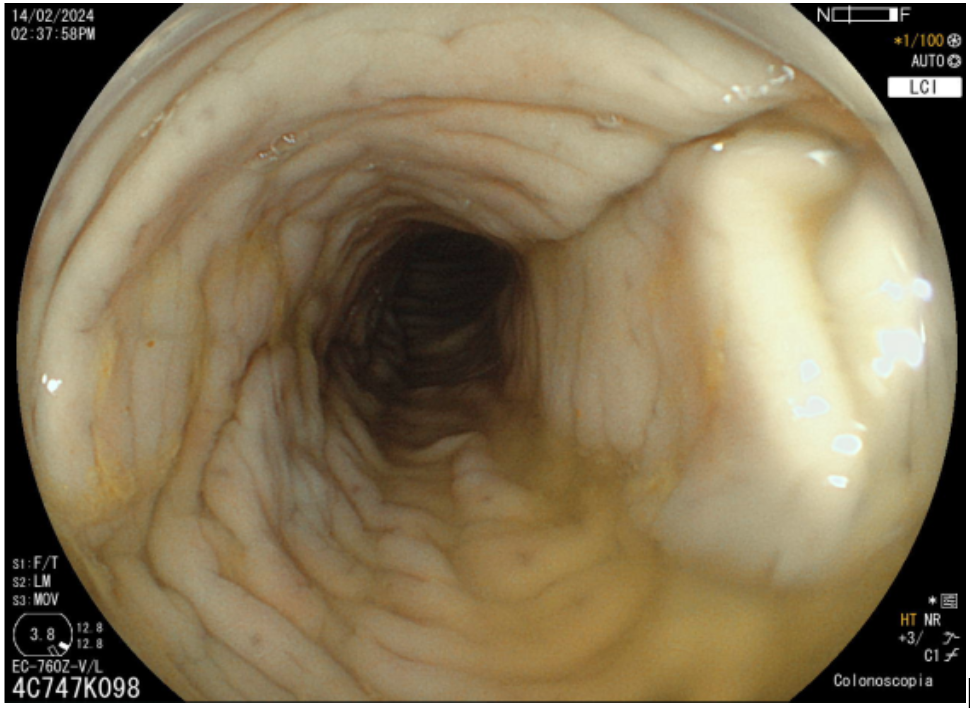Monday Poster Session
Category: General Endoscopy
P3024 - A Surprise During a Screening Colonoscopy: Extensive Colonic Xanthomatosis Associated With Hyperlipidemia
Monday, October 27, 2025
10:30 AM - 4:00 PM PDT
Location: Exhibit Hall

Cinthia Reyes Cruz, MD
University of Miami Miller School of Medicine at Holy Cross Hospital
Fort Lauderdale, FL
Presenting Author(s)
Award: ACG Presidential Poster Award
Cinthia Reyes Cruz, MD1, Carlota Cabrer, MD2, Diego Abreu Delgado, MD3, Cesar Ortiz, MD4, Marcos Martinez, 3, Isabella Mella, MD3, Patricia Yunen, 5, Nemer Dabage-Forzoli, MD1, Fernando Contreras, MD, FACG3
1University of Miami Miller School of Medicine at Holy Cross Hospital, Fort Lauderdale, FL; 2CEDIMAT, Santo Domingo, Distrito Nacional, Dominican Republic; 3Centro de Gastroenterologia Avanzada, Santo Domingo, Distrito Nacional, Dominican Republic; 4Nassau University Medical Center, East Meadow, NY; 5Cedimat, Santo Domingo, Distrito Nacional, Dominican Republic
Introduction: Gastrointestinal (GI) xanthomas are uncommon, benign lesions of the GI mucosa, often identified during endoscopy as yellowish nodules or plaques in asymptomatic patients. Their etiology is not fully understood but is thought to involve lipid-laden macrophages—foam cells—accumulating in the lamina propria, potentially associated with alterations in lipid metabolism and inflammation. GI xanthomas are typically observed as scattered lesions, while a diffuse, coalescing distribution is rare, with only a few cases reported in the literature. These lesions are most frequently found in the upper GI tract, with a reported prevalence of 0.23% to 7%. Colonic xanthomas are less common and less well documented.
Case Description/
Methods: A 50-year-old man with a history of hypertriglyceridemia and coronary artery disease, status post percutaneous coronary intervention, presented to the GI clinic for a screening colonoscopy. Recent laboratory results revealed normal total cholesterol and Low-Density Lipoprotein levels, but an abnormally low High-Density Lipoprotein (< 3 mg/dL) and elevated triglycerides (206 mg/dL).
Colonoscopy revealed abnormal colonic mucosa with notable opacity, absence of typical vascular and glandular patterns, and an edema-like appearance (Figure A). Segmental biopsies demonstrated mild chronic inflammation, focal hyperplastic epithelial changes, and foamy macrophages, confirming the diagnosis of extensive colonic xanthomatosis (Figure B). During follow-up, the patient was informed of the diagnosis and counseled on dyslipidemia management to reduce future risk.
Discussion: While several factors suggest a possible association between colonic xanthomas and cardiovascular disease, this relationship remains unclear. Similar lipid-laden lesions—such as xanthelasma and other extracolonic xanthomas—have shown associations with dyslipidemia and increased cardiovascular risk. Although the clinical significance of colonic xanthomas remains uncertain.
This case highlights the value of screening colonoscopies not only in identifying premalignant lesions but also in detecting benign findings that may be indicative of broader systemic conditions. Interestingly, the relationship between diffuse xanthomatous lesions and malignancy remains uncertain. A case report by Yang et al. described an early-stage esophageal cancer associated with diffuse esophageal xanthomas, suggesting a potential risk factor for cellular derangement and a possible predisposition to malignant transformation.

Figure: Figure A. Endoscopic appearance of extensive colonic xanthomatosis.

Figure: Figure B. Histopathology with evidence of accumulation of foamy macrophages in the colonic mucosa.
Disclosures:
Cinthia Reyes Cruz indicated no relevant financial relationships.
Carlota Cabrer indicated no relevant financial relationships.
Diego Abreu Delgado indicated no relevant financial relationships.
Cesar Ortiz indicated no relevant financial relationships.
Marcos Martinez indicated no relevant financial relationships.
Isabella Mella indicated no relevant financial relationships.
Patricia Yunen indicated no relevant financial relationships.
Nemer Dabage-Forzoli indicated no relevant financial relationships.
Fernando Contreras indicated no relevant financial relationships.
Cinthia Reyes Cruz, MD1, Carlota Cabrer, MD2, Diego Abreu Delgado, MD3, Cesar Ortiz, MD4, Marcos Martinez, 3, Isabella Mella, MD3, Patricia Yunen, 5, Nemer Dabage-Forzoli, MD1, Fernando Contreras, MD, FACG3. P3024 - A Surprise During a Screening Colonoscopy: Extensive Colonic Xanthomatosis Associated With Hyperlipidemia, ACG 2025 Annual Scientific Meeting Abstracts. Phoenix, AZ: American College of Gastroenterology.
Cinthia Reyes Cruz, MD1, Carlota Cabrer, MD2, Diego Abreu Delgado, MD3, Cesar Ortiz, MD4, Marcos Martinez, 3, Isabella Mella, MD3, Patricia Yunen, 5, Nemer Dabage-Forzoli, MD1, Fernando Contreras, MD, FACG3
1University of Miami Miller School of Medicine at Holy Cross Hospital, Fort Lauderdale, FL; 2CEDIMAT, Santo Domingo, Distrito Nacional, Dominican Republic; 3Centro de Gastroenterologia Avanzada, Santo Domingo, Distrito Nacional, Dominican Republic; 4Nassau University Medical Center, East Meadow, NY; 5Cedimat, Santo Domingo, Distrito Nacional, Dominican Republic
Introduction: Gastrointestinal (GI) xanthomas are uncommon, benign lesions of the GI mucosa, often identified during endoscopy as yellowish nodules or plaques in asymptomatic patients. Their etiology is not fully understood but is thought to involve lipid-laden macrophages—foam cells—accumulating in the lamina propria, potentially associated with alterations in lipid metabolism and inflammation. GI xanthomas are typically observed as scattered lesions, while a diffuse, coalescing distribution is rare, with only a few cases reported in the literature. These lesions are most frequently found in the upper GI tract, with a reported prevalence of 0.23% to 7%. Colonic xanthomas are less common and less well documented.
Case Description/
Methods: A 50-year-old man with a history of hypertriglyceridemia and coronary artery disease, status post percutaneous coronary intervention, presented to the GI clinic for a screening colonoscopy. Recent laboratory results revealed normal total cholesterol and Low-Density Lipoprotein levels, but an abnormally low High-Density Lipoprotein (< 3 mg/dL) and elevated triglycerides (206 mg/dL).
Colonoscopy revealed abnormal colonic mucosa with notable opacity, absence of typical vascular and glandular patterns, and an edema-like appearance (Figure A). Segmental biopsies demonstrated mild chronic inflammation, focal hyperplastic epithelial changes, and foamy macrophages, confirming the diagnosis of extensive colonic xanthomatosis (Figure B). During follow-up, the patient was informed of the diagnosis and counseled on dyslipidemia management to reduce future risk.
Discussion: While several factors suggest a possible association between colonic xanthomas and cardiovascular disease, this relationship remains unclear. Similar lipid-laden lesions—such as xanthelasma and other extracolonic xanthomas—have shown associations with dyslipidemia and increased cardiovascular risk. Although the clinical significance of colonic xanthomas remains uncertain.
This case highlights the value of screening colonoscopies not only in identifying premalignant lesions but also in detecting benign findings that may be indicative of broader systemic conditions. Interestingly, the relationship between diffuse xanthomatous lesions and malignancy remains uncertain. A case report by Yang et al. described an early-stage esophageal cancer associated with diffuse esophageal xanthomas, suggesting a potential risk factor for cellular derangement and a possible predisposition to malignant transformation.

Figure: Figure A. Endoscopic appearance of extensive colonic xanthomatosis.

Figure: Figure B. Histopathology with evidence of accumulation of foamy macrophages in the colonic mucosa.
Disclosures:
Cinthia Reyes Cruz indicated no relevant financial relationships.
Carlota Cabrer indicated no relevant financial relationships.
Diego Abreu Delgado indicated no relevant financial relationships.
Cesar Ortiz indicated no relevant financial relationships.
Marcos Martinez indicated no relevant financial relationships.
Isabella Mella indicated no relevant financial relationships.
Patricia Yunen indicated no relevant financial relationships.
Nemer Dabage-Forzoli indicated no relevant financial relationships.
Fernando Contreras indicated no relevant financial relationships.
Cinthia Reyes Cruz, MD1, Carlota Cabrer, MD2, Diego Abreu Delgado, MD3, Cesar Ortiz, MD4, Marcos Martinez, 3, Isabella Mella, MD3, Patricia Yunen, 5, Nemer Dabage-Forzoli, MD1, Fernando Contreras, MD, FACG3. P3024 - A Surprise During a Screening Colonoscopy: Extensive Colonic Xanthomatosis Associated With Hyperlipidemia, ACG 2025 Annual Scientific Meeting Abstracts. Phoenix, AZ: American College of Gastroenterology.

